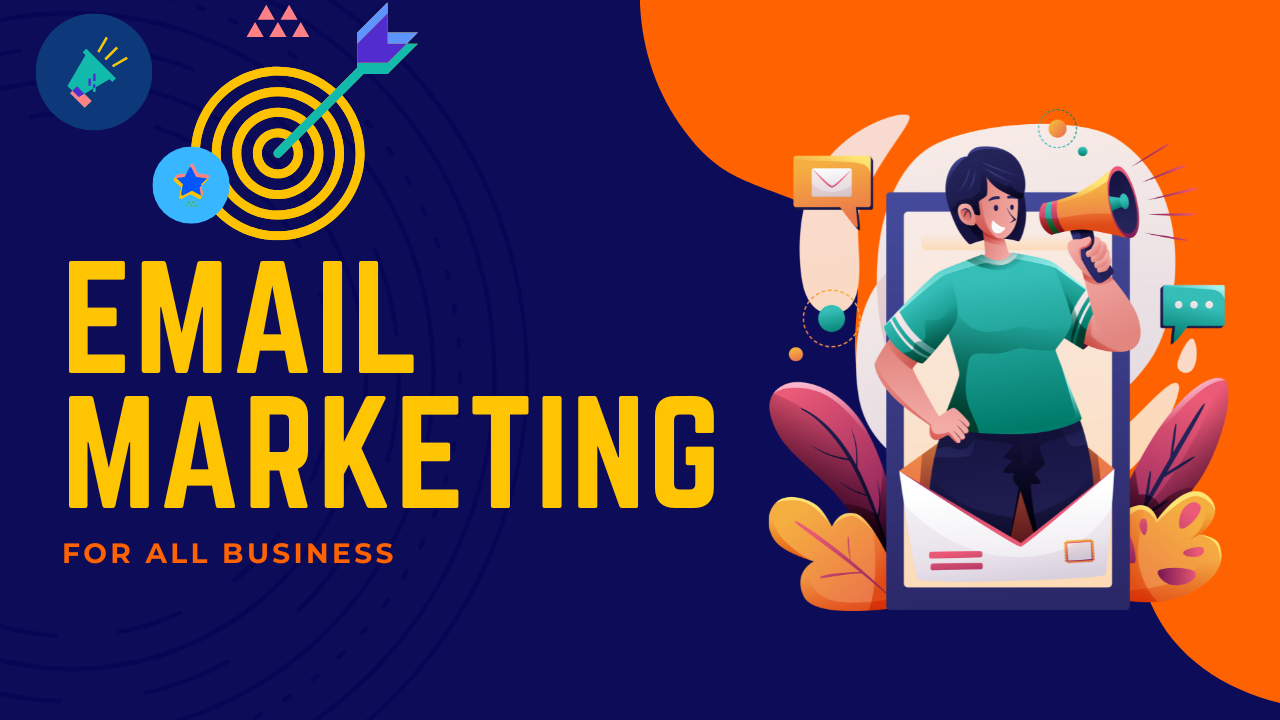What is Email Marketing?
Why Email Marketing is Essential for Businesses Today
- Direct Communication: Emails land directly in the inbox, ensuring your message is seen and received.
- Personalization: With advanced segmentation techniques, emails can be personalized to each recipient, increasing relevance and engagement.
- High ROI: Email marketing continues to deliver one of the highest returns on investment (ROI), with many businesses seeing an average of $42 for every $1 spent.
Benefits of Email Marketing for Businesses
- Cost-Effective: Email marketing is one of the most affordable marketing strategies available. With low overhead costs, you can reach a wide audience without breaking the bank.
- Targeted Reach: Unlike traditional marketing channels, email allows you to send highly targeted messages to segmented audiences, ensuring higher engagement and conversions.
- Measurable Results: With the ability to track open rates, click-through rates, and conversions, email marketing gives businesses the tools to measure success and improve campaigns over time.
- Scalability: Email marketing can easily scale as your business grows, ensuring that you can continue to reach a larger audience without increasing costs significantly.
Key Components of an Email Marketing Strategy
- Email List Building: You need a clean, segmented list of subscribers who have opted in to receive your communications. A strong email list is the foundation of a good email marketing strategy.
- Segmentation: Dividing your list into smaller groups based on customer demographics, behaviors, or past interactions will ensure you send relevant messages that resonate with each group.
- Content Creation: The content of your emails should be valuable, informative, and engaging. Focus on providing real value to the recipient.
- Automation: Setting up automated email campaigns can save time and ensure that the right message is sent to the right person at the right time.
- Testing and Optimization: Regularly testing different email elements such as subject lines, content, and call-to-actions is essential for optimizing your strategy and improving performance.
How to Create an Effective Email Marketing Strategy
- Set Clear Objectives: Define the goals of your email marketing campaign. Are you aiming to increase sales, promote new products, or build brand awareness?
- Segment Your Audience: Divide your audience into segments based on various factors such as demographics, buying behavior, and engagement history.
- Craft Engaging Content: Ensure your emails provide value. Whether it’s offering a discount, sharing a blog post, or announcing new products, the content should be informative and engaging.
- Choose the Right Email Marketing Tool: Select a platform that fits your business needs. Popular tools like Mailchimp, HubSpot, or Constant Contact provide robust features for managing campaigns, automating emails, and tracking performance.
- Measure and Optimize: Keep track of your email campaigns’ performance and use analytics to make data-driven decisions to improve future campaigns.
B2B Email Marketing: Why It’s Different
- Professional Tone: Emails to business clients should be professional, focusing on how your product or service can solve their business challenges.
- Personalized Outreach: B2B campaigns should focus on the specific needs of the business and target decision-makers, ensuring that emails are relevant and helpful.
- Longer Sales Process: The sales cycle in B2B is usually longer, and email marketing can be used to nurture leads over time with educational content, case studies, and webinars.
Successful B2B Email Marketing Tactics
- Segmenting by Industry: In B2B marketing, targeting different industries can significantly improve the relevance of your messages. Tailoring content for a specific industry’s needs increases engagement.
- Drip Campaigns: B2B email marketing often involves drip campaigns that nurture leads over time, providing useful content and gradually moving them down the sales funnel.
- Providing Case Studies: Sharing case studies of how your product or service has benefited similar companies can help build trust and demonstrate value.
How Email Automation Can Improve Your Campaigns
- Streamlining Efforts: Automation reduces the need for manual intervention, making your email marketing campaigns more efficient.
- Personalized Emails at Scale: Automation enables businesses to send personalized emails to thousands of recipients without losing the personal touch.
- Increased Engagement: Automated emails, such as re-engagement campaigns, can help keep your audience engaged, improving overall campaign performance.
Setting Up an Email Automation System
Benefits of Using Email Automation for Your Business
- Efficiency: Automation saves time by handling routine tasks, allowing marketers to focus on strategy.
- Consistency: Automated emails ensure that customers receive timely communication.
- Scalability: As your business grows, automated systems can handle increasing numbers of contacts and emails without additional resources.
The Best Email Marketing Tools for Success
- Mailchimp: Offers user-friendly interfaces and powerful features for automating campaigns, tracking performance, and personalizing emails.
- HubSpot: Known for its robust email marketing and CRM integration, HubSpot is ideal for businesses looking for an all-in-one solution.
- Constant Contact: Great for small businesses, with easy-to-use templates, automation, and detailed reporting.
Features to Look for in an Email Marketing Tool
- Automation Features: Look for tools that allow you to set up automatic workflows, such as welcome emails or re-engagement sequences.
- Segmentation Capabilities: Ensure the tool offers easy segmentation to target different customer groups based on behavior, interests, and demographics.
- Analytics and Reporting: Advanced reporting tools allow you to track the success of your campaigns and make data-driven decisions.
How to Choose the Best Email Marketing Tool for Your Business
Newsletter Marketing: An Often Overlooked Strategy
How Newsletter Marketing Can Build Customer Loyalty
Tips for Creating Engaging Newsletters
- Personalization: Include the recipient’s name and tailor content to their preferences for higher engagement.
- Compelling Subject Lines: Your subject line is the first thing recipients see—make it catchy and relevant.
- Clear CTAs: Include clear and actionable calls-to-action to guide recipients on what to do next.
Real-World Examples of Email Marketing Success
- Amazon: Personalized product recommendations based on browsing history and previous purchases.
- Starbucks: Email campaigns that promote rewards, seasonal offers, and loyalty programs.
Success Stories from Top Brands Using Email Marketing
- Nike: Uses email marketing to promote limited-time offers and personalized recommendations, leading to increased sales and customer retention.
- Sephora: Their email campaigns focus on personalized beauty tips and loyalty rewards, driving repeat purchases.
Email Marketing Trends to Watch in 2025
- AI-Driven Personalization: AI will continue to revolutionize how emails are personalized, making campaigns more relevant.
- Interactive Emails: Emails with interactive elements, like quizzes and polls, will become more popular.
How to Measure the Success of Your Email Marketing Campaigns
- Open Rate: Percentage of recipients who opened your email.
- Click-Through Rate (CTR): Percentage of recipients who clicked on a link in your email.
- Conversion Rate: Percentage of recipients who completed a desired action (e.g., purchase, download).
Frequently Asked Questions (FAQs)
1. What is the best time to send marketing emails?
The best time varies by industry, but studies suggest early morning or late afternoon on weekdays yields the highest open rates.
2. How often should I send marketing emails?
Sending emails too frequently can lead to unsubscribes. Aim for 1-4 emails per month, depending on your audience’s preferences.
3. Can email marketing help me with customer retention?
Yes, email marketing is highly effective at nurturing relationships and retaining customers by providing valuable content and offers.
Conclusion: Unlocking the Full Potential of Email Marketing
Email marketing remains a powerful tool for businesses seeking to boost sales and foster customer loyalty. By creating a tailored strategy, leveraging automation, and using the best tools available, businesses can unlock the full potential of email marketing to drive growth and success.

